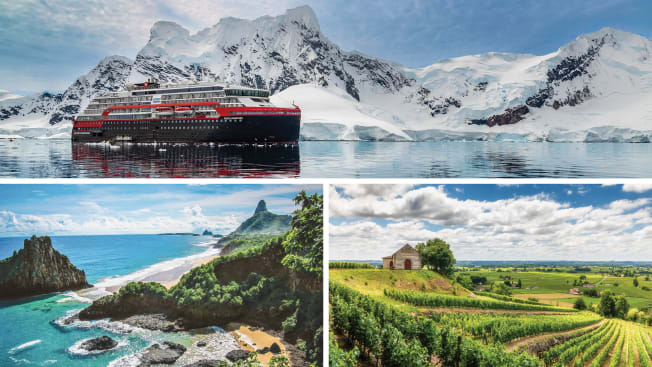Here's how you can enjoy a luxury trip or upgrade the one you've got planned without breaking the bank

Luxury travel to places as diverse as the Antarctic coast (top), the beaches of Brazil (above left), and vineyards in Bordeaux (above right) can be budget-friendlier than you think.
By Jesse Will
With the world well past the pandemic’s peak, Americans are showing a strong thirst for travel in 2023. Almost a quarter of us plan to travel more for leisure this year than last, according to a U.S. Travel Association study. Vacation rental bookings are up. Flights are full. Itineraries are ambitious.
“Travel is back, full force,” says Mary Cropper, a travel adviser in Boston. “People are coming out of the woodwork after the pandemic, really investing a lot of time and energy to curate the perfect trip.”
And because demand is up, leisure travel prices continue to stay high. Airline tickets may come in slightly cheaper than in 2022—a ticket costing $400 last summer might hit around $350 this year, according to the travel booking site Hopper—but that’s still higher than pre-pandemic rates. And inflation has jacked up costs for everything from hotels to rental cars to restaurants.
But with some foresight, research, and perhaps the help of a good travel adviser, it’s still possible to arrange the big trip you’ve been dreaming about without having to start selling off your furniture. Here’s how.
New Places to Go
Find Where Your Dollar Goes Further
It’s easy to max out your travel budget when the destination is a perennially pricey locale like Maui or New York City. But with the dollar staying strong during the global economic downturn, this might be the year to make the most of a favorable exchange rate. At press time, the dollar was still performing at relative highs against the euro, Japanese yen, and Chinese yuan, aka renminbi. In 2014 the British pound was worth about $1.70; now it’s worth about $1.20. The Argentine peso, Costa Rican colón, and Brazilian real are all at a discount of late, too. So a fab five-star retreat at any of one of these destinations might now be within reach.
Identify Emerging Destinations
Balking at the cost of a given trip, whether it’s a beach all-inclusive or a more complex itinerary? Consider another sweet spot in the same vicinity. Keith Waldon, a travel adviser in Austin, Texas, suggests talking to a destination specialist who’s an authority on an area. “Maybe you’re interested in the Amalfi Coast but don’t want to pay the high-season rates,” he says. “A destination specialist might steer you toward the more affordable Tuscan coast, where there are gorgeous towns to explore and where you can hop on the train to Florence for a day trip.”
Make the Most of Shoulder Season
If you aren’t at the mercy of a school schedule and don’t need to travel when everyone else is—in July and early August, for example—you can stretch your budget by traveling at off-peak times, when hotel prices can be as much as 50 percent lower. Along with gentler prices, you might find the weather almost as good or better. But because shoulder seasons aren’t at the same time everywhere, hit the internet or ask a travel adviser familiar with the area about specialized seasonal intel. You’ll find fewer crowds and better deals visiting Hawaii in mid-April or May; Hilton Head Island, S.C., in September; the Grand Canyon in October; and Mexico City in March. At Caribbean resorts, the June to November hurricane season can present significant discounts, but purchase trip insurance.
Book Your Flights Early
“People have the misconception that it’s cheaper to go last-minute, but things have changed since the pandemic,” says Gai Spann, founder of Spanning the Globe Tours. “Instead of flying half-full flights, airlines are canceling them. The bottom line is that they don’t need your last-minute fare anymore, so you’re better off shopping early.” To understand what you should realistically expect to pay (and what’s a deal), Spann recommends getting familiar with a route’s usual and predicted cost at such sites as Google Flights, Hopper, and Skyscanner. The cheapest day to book, on average, is Sunday, according to a recent report from the Airlines Reporting Corp. and Expedia. The most expensive tends to be Friday. Starting a domestic trip on a Wednesday vs. Sunday or Monday can save you up to 15 percent.

Clockwise from left: A waterfall in Hawaii, the Grand Canyon, and the Palace of Fine Arts in Mexico City.
Photos: Katrina Brown/Adobe Stock, Matteo Colombo/Getty Images, John Coletti/Getty Images
Great Places to Stay
Go Luxury Camping (or ’Glamping’)
The fresh-air trend that gained speed during the pandemic has shown no signs of slowing. Case in point: the growing network of national-park-adjacent safari-inspired accommodations from Under Canvas, where you can have a unique overnight experience near some of America’s natural wonders without needing to buy a boatload of gear to do it. The locations—near Yellowstone, Zion, Grand Canyon, Acadia, and other national parks—offer restaurants, adventure concierge services, and en suite bathrooms. Nights at Under Canvas locations start under $200. Also check out Terramor, the campground network KOA’s entry into glamping (glamorous camping), featuring Frette linens and WiFi in each tent, in Bar Harbor, Maine. The Resort at Paws Up in Greenough, Mont., features 36 ultraluxe tents on the Blackfoot River.
Try a Better All-Inclusive
If the term “all-inclusive” makes you think of watered-down drinks and bad buffet food ... sure, places like those are still around. But a growing number of resorts that are all-inclusive—meaning you pay a flat fee per traveler that generally includes lodging, food, drinks, and some activities—are luring guests by leveling up. Palmaïa, the House of AïA, in the Mayan Riviera in Mexico, for example, features swim-up suites, yoga programs, and meditation sessions. On the Greek island of Kos, Ikos is presenting a new all-inclusive concept: dining out at a local restaurant as part of your all-inclusive cost. “All-inclusives are about having no hidden surprises,” Waldon says. “Some people want to put their wallet away and not have to think about signing another bill.”
Look for a Historic Hotel
If you are headed to the Iberian Peninsula: In Spain, consider a stay at one of the 90-plus paradores, a network of hotels converted beginning in the 1920s from architecturally significant or restored historic buildings and castles. Take Parador de Corias: At the former monastery, built in the 11th century, you’ll find luxury accommodations with sweeping countryside views, along with a spa, restaurant, and pool. In Portugal, you’ll find over 40 pousadas, also restored historic sites. Paradores and pousadas tend to feature elevated local fare and beautifully appointed rooms, some for under 100 euros per night, including meals.
Book a Ritzy Rental
Compared with staying at a hotel, comfortable luxury rentals with amenities like a well-equipped kitchen and swimming pool can lower the cost of food, drinks, entertainment, and transportation, especially if you’re traveling with a group. You’re also likely to have a more authentic experience staying in an area where the locals live. In addition to Airbnb and Vrbo, consider alternative options such as Airbnb Luxe, Onefinestay, and Plum Guide for posh rentals. Booking a homestay using points is an option, too, via Homes & Villas by Marriott Bonvoy.

All-inclusive resorts can be luxurious these days. But the fancy ones have the same everything-included pricing that makes them a deal if you like to drink or eat well. The Ikos resort on the Greek island Kos (shown above) offers a dramatic setting and Michelin-starred chefs.
Photos: IKOS
Deals and Discounts
Request a Room Upgrade
In addition to asking nicely, you’re more likely to get a room upgrade if you’re a member of a hotel’s loyalty program (and even more likely if you carry its co-branded credit card). Travel advisers can help, too. If you already have your eyes on a luxury property, you might search online for a travel adviser that has “preferred agency” status with that brand, whether it’s the Four Seasons, Mandarin Oriental, Rosewood, or something else. “Preferred agencies might give their clients a complimentary upgrade, plus breakfast for two daily, spa credits, and even airport transfers,” says Waldon, the travel adviser in Austin. “You can access that just by booking through a travel agency with standing in that program.”
Find a Package Deal
Even if you’re a savvy traveler adept at shopping for flights, resorts, cars, and cruises à la carte, don’t dismiss package deals put together by reputable travel agents or . . . your favorite warehouse club? Indeed, Costco can book members to Botswana, Ireland, Bordeaux, and beyond. The surprisingly luxe travel packages are available both in-store and online, and are backed by clear cancellation policies and the retailer’s robust customer service. Perks like free transfers, credits, and meals are often included. To make sure the deal’s a good one, double-check fares with those on online booking sites. Expedia also features an array of package deals sorted by interest, including golf vacations in Palm Springs, Calif., and couples getaways in Paris.
Take a Cruise
Cruise itineraries are getting ever more interesting, with slow-speed European river barge cruises surging in popularity along with luxury “expedition” trips to places like the Arctic Circle. Look to outfitters like Hurtigruten for bucket-list itineraries like Circumnavigating Iceland, a nine-day trek from $4,721, or a seven-day Galápagos Islands Expedition Cruise from $6,082. On the lower-priced end of the spectrum are the mega-ships sailing from the world’s busiest passenger ports. Deals for those can often be had if you book very early or closer to the departure date. Because the cruise lines make a large portion of their money from onboard purchases, they seek to sail full ships. Check sites like CruiseSheet for bargains.
Consider 4 Stars Over 5
If you’re booking a luxury stay in Europe, you can save money by opting for a four-star hotel rather than a five-star, and get much the same experience, Waldon says: “The star rating is very strict in Europe, and there are some superluxury properties that don’t get a five-star rating because they don’t have a top-level restaurant or room service. But if you’re in the heart of Paris or another European city that’s surrounded by great restaurants, you probably won’t care.” A few of Waldon’s favorite luxury value places are Pavillon Faubourg Saint-Germain in Paris, often priced at a fraction of the price of five-star hotels like the Shangri-La and the Ritz; the Chesterfield Mayfair in London; the Hotel Santa Maria Novella in Florence, Italy; and the Kimpton Charlotte Square in Edinburgh, Scotland.

Costco offers members multiple package deals to Ireland that include stops in Dublin (top right) and respites along the coast (above left and bottom right).
Photos: Adobe Stock, Jon Chica/Adobe Stock, AJ Wattamaniuk/Getty Images
Secret Addresses
Leverage Blogs and Social Media
Doing some digital homework can lead you to the restaurants that locals love. Look to recent “best of” guides from such sites as Eater and The Infatuation, or search for dining blogs. If you have Instagram, use that, too. “Social media makes it much easier to see what a restaurant or attraction is really like through vignettes and videos,” says Spann at Spanning the Globe Tours. Find a restaurant’s hashtag on Instagram, then look at the most recent photos and videos. Along with the glamorized takes, you’ll see photos and videos of what the food and the place are really like.
Try a Tourist Pass
Carrying a discount card with some of your destination city’s most popular attractions might make you feel like a tourist. But that’s okay. Do some research at operators such as CityPass and Go City, and you might realize that you could save money by getting one, or end up hitting locations you otherwise might have skipped. But check to make sure the math works in your favor. If you’re planning on visiting just a few highlights, such as the American Museum of Natural History and the Empire State Building in New York City, a two-choice Go City Explorer pass for $79 will cost you $3 more than paying those two admission fees separately. If you’re planning a wall-to-wall, tour-packed itinerary in a location like Oahu in Hawaii, a three-day all-inclusive Go City pass for $229 could save you $475 vs. separate admission fees for Pearl Harbor museums, a luau, Sea Life Park, a sailing trip, and other excursions.
Free-Admission Smarts
Across the globe, many institutions have specific days (or nights) of the week or month where admission is free or donation-based. Do the research and you could save a bunch. If your family has a membership to a local museum, zoo, or botanical garden, check to see if there are reciprocal arrangements with other museums or cultural sites. The North American Reciprocal Museum Association, for example, offers free member benefits to over 1,200 institutions.

New York City sites (clockwise from top left): Hall of Ocean Life at the American Museum of Natural History; a person looking through coin-operated binoculars; and the Guggenheim Museum on the Upper East Side.
Photos: AMNH/D. Finnin, Adobe Stock (2)
Editor’s Note: This article also appeared in the May/June 2023 issue of Consumer Reports magazine.
Consumer Reports is an independent, nonprofit organization that works side by side with consumers to create a fairer, safer, and healthier world. CR does not endorse products or services, and does not accept advertising. Copyright © 2023, Consumer Reports, Inc.
